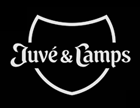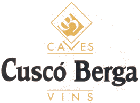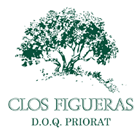Mascaró
by
Kathy and Terry Sullivan
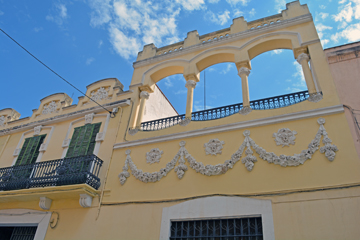 Summary: Mascaró winery in Vilafranca continues on through the work of Montserrat Mascaró, granddaughter of the original founder. Today the winery continues producing cavas, wines, and spirits.
Summary: Mascaró winery in Vilafranca continues on through the work of Montserrat Mascaró, granddaughter of the original founder. Today the winery continues producing cavas, wines, and spirits.
History and Vineyards
Mascaró has been producing cavas, still wines and distilled spirits for three generations. Today the enthusiastic and informative granddaughter, Montserrat Mascaró has taken over the reins of the company and is the winemaker. Mascaró is located in Vllafranca near the train station, a perfect location for distribution of cava. Cavas are aged, riddled, disgorged and labeled at this location. During our tour we learned that the Mascarós were producing the distilled spirits in the same location from the 1940s to the 1960s. As the city grew, regulations in the 1960s required that distilled spirits production take place outside of the city.
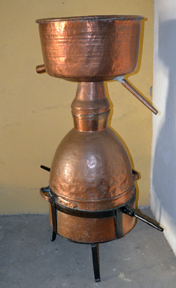 Now, the cava base wines are also produced outside of the city limits, where the grapes are gently whole cluster pressed to obtain 50 percent of the possible juice. Any additional juice and skins are used for spirits production. Currently Mascaró produces reserva and gran reserva cavas. Since the winery wants to thoroughly control the winemaking process, only grapes from their own vineyards are used for producing cavas and still wines.
Now, the cava base wines are also produced outside of the city limits, where the grapes are gently whole cluster pressed to obtain 50 percent of the possible juice. Any additional juice and skins are used for spirits production. Currently Mascaró produces reserva and gran reserva cavas. Since the winery wants to thoroughly control the winemaking process, only grapes from their own vineyards are used for producing cavas and still wines.
A vineyard located in the northern Penedés region was once owned by the Cistercian monks. The majority of grapevines in this vineyard are 70 years old. Grape varieties include Xarel.lo, Cabernet Sauvignon, Merlot, Garnacha, Sauvignon Blanc and Chardonnay. In addition they are growing eight hectares of Uni Blanc for use in their spirit production. At harvest time, all grapes are hand harvested. Grapes for the production of spirits are a combination of their own grapes and purchased grapes. Mascaró now produces 100,000 bottles of cava and 200,000 bottles of spirits.
We enjoyed visiting the house of the Mascaró family that is built in the modernist style. Prior to establishing the Mascaró brand company, Montserrat’s Grandfather Narciso Mascaró was producing a brandy, a cava and an orange liquor. At the time the family was growing grapes and making bulk wines. The family was already making wines so Narciso decided to make his own commercial products in 1945. While he produced the cavas and spirits, his brother in Switzerland marketed the products.
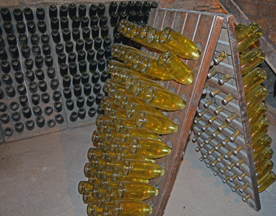 Vilafranca Production Site
Vilafranca Production Site
The current site in Villafranca is used for the cava addition of licor de triage, the secondary fermentation, aging, disgorgement and bottling. Our tour led to several locations. The caves at Mascaró were built in the 1940s. As we walked through the caves, we noticed an old belt used to move bottles from one gallery to another. In the galleries, cava bottles are resting like horizontal children sharing a dormitory bed. Both wood and cement riddling racks are used to riddle some cava bottles. Stop a moment at the casal, minus the sand. A casal was a sand box that was used to hold the cava bottles vertically, neck down. The street where this production is located is called Casal Street.
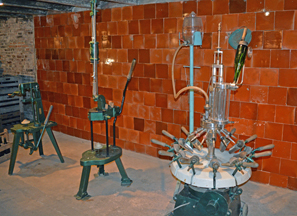 In one long hallway in the cellar we saw several vintage pieces of equipment that once were used in cava production. These are museum pieces that still function properly, and provide learning tools for enologists and interested wine enthusiasts. Three riddling racks with bottles line one end of this brick hall. Ebony tables used during cava tasting special events make this chamber a wonderful location.
In one long hallway in the cellar we saw several vintage pieces of equipment that once were used in cava production. These are museum pieces that still function properly, and provide learning tools for enologists and interested wine enthusiasts. Three riddling racks with bottles line one end of this brick hall. Ebony tables used during cava tasting special events make this chamber a wonderful location.
Our tour continued up a level to one of the tasting rooms where we met Montserrat Mascaró. When asked about her fondest memories of the winery, Montserrat replied that she remembers her grandmother. Montserrat remembers working in the cellar when she was 13 years old. She also remembers traveling with her father especially to Scotland and the Cognac region of France. For Montserrat the best part of winemaking is the blending process. We asked about the company logo on wine bottles. The Mascaró logo was chosen to represent a beast of fantasy. The logo is comprised of half a lion and half a man.
At Mascaró the focus is to make products that they like and hope people will enjoy.
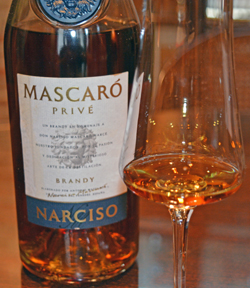 Tastings
Tastings
We tasted the Privé Brandy that had 40% alcohol. This brandy was produced with Parellada grapes and was a dark amber color. The brandy offered notes of dried fruits including apricots and oranges with some floral notes. There was a nice orange aftertaste that gave way to dried apricots.
The Licor de Naranja was 40% alcohol. It was distilled to get a neutral alcohol, then orange skins were added. The Licor de Naranja was a clear color with a very orange aroma and taste. It was delicious. The Licor de Naranja dates back to Montserrat’s grandfather who first distilled it and she wants to continue his legacy. It was simply delicious.
Cavas
The 2012 Rubor Aurorae was a Brut Rosé that had a red color with orange hue. This 100% Garnacha had an aroma of strawberries and raspberries. There was minerality, notably chalk on the taste along with strawberries and raspberries. The finish was fruity.
The 2013 Nigrum Brut Reserva was a blend of 60% Parellada, 30% Macabeo and 10% Xarel.lo. This yellow colored cava had multiple beads of bubbles forming a mousse on the surface. The aroma and taste offered apple and mineral with a lively to aggressive mouthfeel. Mineral was noted on the finish.
The Cuvée A.M. Brut Nature Gran Reserva was comprised of 50% Macabeo, 35% Parellada and 15% Chardonnay. The light yellow colored cava had lively beads of bubbles. The aroma offered freshly baked bread and green apple, while the taste had green apple with a creamy texture and an aggressive mouthfeel. The finish was green apple and freshly baked bread.
Wine Tourism
Look for a yellow, late modernist building with a white, floral garland, ornamental facade. In the future, the Mascarós will focus on new products related to things in the area and personal products.
Mascaró offers tours of the caves in Vilafranca.
Mascaró is open through the year on most Tuesdays and Thursdays in the morning from 9 to 12 and late afternoons from 15 to 18h.
For reservations contact Mascaró winery.
Mascaró
C/ Casal,9
08720 Vilafranca del Penedès
(Barcelona), Spain
Article written June 2015
Please support the following.
 |
|||
 |
 |
